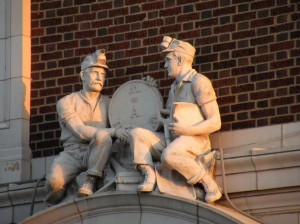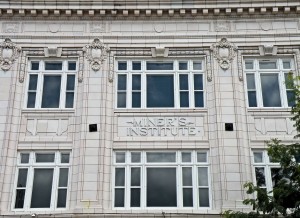By Rachel Heston-Davis – Metro Independent Contributor
For several years, one of Collinsville’s best-known historic landmarks has been at a crossroads. The Miner’s Theatre, once a cultural hub for the city, has sat quiet and empty at the corner of Main and Center streets as city residents debate if it can be salvaged—and if it even should be.
The 96-year-old theater is still impressive despite its age. At three stories high with large windows, it commands attention in its little section of Main Street. However, expensive renovation estimates and a long period of vacancy led many residents to question its usefulness.
Plans to restore it have come and gone, with some residents defending it and some urging for its demolition. Many who admire the building questioned if it could ever be made economically viable again and were opposed to the use of public funds for restoration.
Miner’s has had a long history of ups and downs in the last century. It began life as a meeting and entertainment venue for Collinsville’s coal-mining families. During the second half of the 19th century, coal mining was the most important industry in Collinsville, with 1,786 workers employed in town and production at around 1,897,670 tons of coal. In 1916, union workers decided to build a theater that would serve the coal unions, their families, and the community. After getting a loan from the United Mine Workers of America, miners all over Collinsville chipped in one percent of their salaries to help pay for the building. The three-story Miner’s Theatre was dedicated on Saturday, Dec. 28, 1918.
The building provided offices and meeting rooms for the coal miners’ unions, as well as an auditorium with more than 500 seats and a spacious ballroom. The Collinsville library was housed there for a time. It offered cultural and entertainment possibilities well beyond what many small mining communities could muster.
Miner’s continued to serve the community even after the demise of the coal industry. Decades later, in 1969, Bloomer Amusement Company purchased it and turned it into a full-time movie house. Bloomer’s closed the theater in 1984. Several years later, the Miner’s Institute Foundation (MIF) took ownership and hosted plays, conventions, concerts, pageants and more.
The CARD era
The troubles for the building began as it grew older and in need of repairs. In 2008, the Collinsville Area Recreation District purchased Miner’s and launched a remodeling and expansion plan with mixed public support.
The first phase of improvements was carried out over a period of three years and included a new fire protection system, replacement of exterior fire doors, steel beam stage supports, a new theater light panel, and many cosmetic improvements to windows, masonry and tuck-pointing. These improvements, along with architect/engineers’ fees, cost CARD $753,875. They received $235,000 in TIF money from the city over the three-year time span. In total, CARD spent more than $1.6 million on restoration of the building.
Long-term plans had included expanding the building, but public support dropped away as expenses mounted. Many Collinsville residents felt the project wasn’t worth spending such a large sum of public funds. After much controversy, the plan was abandoned in 2011.
The building was subject to more controversy in 2013 when CARD handed it back to MIF. According to the rules and regulations of TIF fund disbursement in the City of Collinsville, a property owner must retain a property for four years after the completion of a TIF project, or reimburse the city for 25 percent of TIF funds expended per year for the remainder of the four-year period. In the case of Miner’s, however, this debt was forgiven, and the city chose not to enact their right to put a lien on the property.
A fresh re-start
Now, a fresh group of board members at MIF wants to put Miner’s troubled past to bed and get a fresh start. They believe community support is once again rallying around the building. Their new plan calls for renovation and re-opening by 2018.
“Miner’s is one of the largest buildings on Main Street and boasts beautiful architecture unlike any other structure in the uptown area,” said Leah Joyce, board president for the Institute and Uptown Coordinator for the City of Collinsville. “Restoring and re-opening the facility will create a one-of-a-kind entertainment, cultural, and educational facility which will keep resident’s dollars in Collinsville and attract new visitors.”
Joyce and other board members believe this building brings something important to the atmosphere of the city. That’s why, in 2013, they accepted the task of restoration. The building is structurally sound but needs many updates to comply with requirements of the American’s with Disability Act, as well as much cosmetic work. The cost seemed prohibitive to many residents when the Collinsville Area Recreation District tried to restore the building between 2008 and 2011, and controversy over the use of public funds for the project was often sharp.
The new MIF board, however, believes that public opinion has shifted. This is due in part to the project being taken over by a private institution rather than a government operation spending public funds.
“It’s just so expensive to redo an old building such as that,” said board member and business owner Jerry Dallape, who owns Dean’s Liquor next to the theater. “At first a lot of money was coming from the city and CARD, and a lot of people aren’t willing to spend money on a project such as Miner’s not knowing if it’s going to be a money maker.”
He added, “But now the city is out of the picture, CARD is out of the picture, and it’s just Miner’s Institute, it’s a little bit different.” Dallape says that even in the past six months, he’s seen a marked increase in public interest for the project.
Board members believe their plan, which ditches the expansion idea and focuses on opening the ground floor first, is more feasible. Restoration needed to open the first floor includes a new set of restrooms; automatic doors; a fire notification system; wheelchair accessibility to the stage and backstage areas; a new HVAC system; electrical upgrades; third floor insulation; and cosmetic improvements to the interior.
All totaled, the estimated cost is $500,000. Over the past few months, private donations have come from organizations like Collinsville Progress and Landmarks Illinois, as well as the board’s Rally.org page. Local businesses have hosted fundraisers. Other businesses have offered free services and goods, such as electrical repair, carpet and logo redesign. Joyce estimates that more than $20,000 has been donated in cash and in-kind services.
They hope to bring down costs substantially by involving the vocational center at the High School in some of the building repairs. Although some things, like the fire alert system, must be done professionally, the vocational center will be able to provide much money-saving labor in other areas.
Another possible explanation for the community’s new warmth toward Miner’s could be the recognition of the building’s historic value.
“It’s the heritage of Collinsville,” says board member Shameem Coppotelli. She’s also on the board of Edwardsville’s “Curtains Up” community theater group, and has performed in Miner’s. In Coppotelli’s eyes, the building’s history makes it stand out from other auditoriums and performance halls in the area. “It’s just history. You can’t walk into that [in most theaters] now; everything now is very ornate, but it’s not real.”
It is true that the theater has tangible historic ties to many families in Collinsville. The Wall of Honor in the lobby displays plaques with the names of miners from the turn of the century. Many of the last names on that wall, such as Picatto, Tidwell, Stamen and Pitol, can still be found in town today.
Even the interior design harkens back to another age. The lobby boasts a large wooden ticket counter, with popcorn maker front-and-center. Red velvet curtains hang in the theater doorway, the flower pattern in the carpet is reminiscent of Victorian times, and the walls feature elegant wallpaper, crown molding, and in some sections, marble.
The building’s historic value has been recognized by several organizations over the past 30 years. In 1985 it was listed on the National Register of Historic Places. In 1993 it became a Collinsville Progress Historic Landmark. Finally, in May of 2013, the City of Collinsville and the Historic Preservation Commission named it a Collinsville Landmark.
Possible center of a revitalized uptown
Many board members also see a practical side to restoring the theater: the revitalization of the Main Street area.
“It would be the center point of the city,” said Dallape. “There’s really no rallying point for the city other than Miner’s.”
He sees a “resurgence” happening in Collinsville as restaurants and entertainment bring in more young people. “If we could get Miner’s up and running, I think it would be a tremendous boon to uptown.” He adds, “Collinsville’s coming around, but I think we need a focal point.”
“It would be local, it’s in our backyard, it’s historic,” said MIF Fundraising Chair Eric O’Donnell. “I don’t understand why people wouldn’t want it; [we] have to drive all the way to Edwardsville or O’Fallon to catch a movie, or St. Louis to see a concert.”
The auditorium holds about 500 people on the main floor with an additional nine rows in the balcony, and could host movies, plays, concerts, and many other types of functions that the building was originally intended to host.
MIF Treasurer Bill Judge sees a restored Miner’s being an integral part of Collinsville’s uptown area. Rather than just the occasional show or play, he envisions a venue that is “open continuously.” He added, “And I think it will be…a boon for downtown.”
“Once [residents] see that we’re going to open it and start having functions, I do believe that people will start rallying around it,” Dallape said. “Down the line it really will support itself.”
“Main Street has undergone such a dramatic revitalization in the past 10 years, and the reopening of the theater will further strengthen the commercial, hospitality and tourism sectors of the resurging uptown area,” Joyce said.
“I think it’s just getting word of mouth [out there] that somebody is doing something to reopen the theater,” said O’Donnell. “For years and years, it’s just been there. It’s empty….The more things we do and the more we get our name out there, people will get behind it.”
If the MIF reaches their goal, they will re-open the first floor of the theater in time for Miner’s 100th birthday in December of 2018. It’s a long way to go, but many are hopeful for the future of this historic theater.






